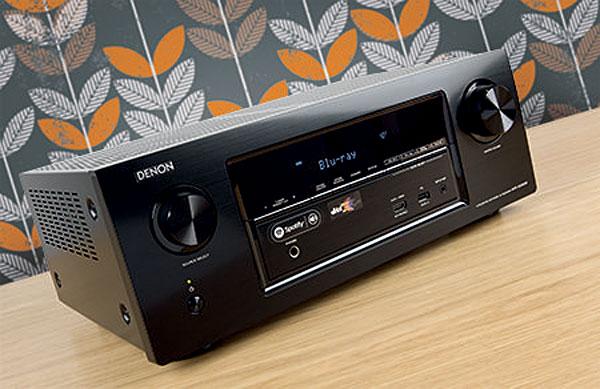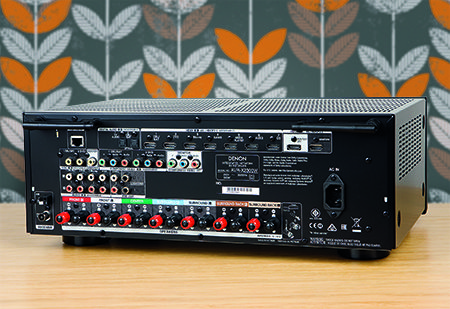Denon AVR-X2300W review


It's a seven-channel Dolby Atmos AV receiver (claiming a 95W-per-channel – into eight Ohm – measurement via its discrete amp design), so made for 7.1 or 5.1.2 setups. DTS:X wasn't available at the time of review, but a firmware update is promised. Auro-3D, while offered on more expensive Denon amps as a paid upgrade, isn't an option – not least because the X2300W doesn't have the channel output to do it justice.
The feature set is comprehensive. Ethernet/Wi-Fi and Bluetooth connections cater for audio streaming, with format compatibility ranging from the prosaic (MP3) to the esoteric (DSD 5.6MHz). These are backed up by AirPlay, Spotify Connect and 'net radio integration. Room EQ is provided via Audyssey's MultEQ XT platform (with dynamic volume/EQ functionality). There are dual outputs for twin-subwoofer setups.
HDMI provision is bang up-to-date, too. The amp features eight inputs (one front-mounted) and twin outputs, with HDCP 2.2 and 4K/HDR support across the board. Below these on the backpanel you'll find some (but not an overload of) analogue inputs and legacy AV connections.
While not integrated with Denon's HEOS multiroom kit, running a second audio zone is an option.
Of course, as a machine crafted to hit a specific, relatively low, price-point, the Denon does show some signs of corner-cutting. Firstly, while the overall aesthetic is pleasant enough – though very much adhering to the time-honoured 'two-knobs-and-a-display' design – get up close and you'll discover the central portion of the fascia is hewn from plastic. Then there are features missing that some buyers may want and will have to look for elsewhere, such as multichannel analogue inputs, Denon's proprietary Link connection standard (for use with its BD player line), and 12V trigger output.
The AVR can be controlled via a free app, or the supplied handset. The latter is rather lightweight and generally free of button clutter. There are source keys for Blu-ray, CD, etc – as opposed to the once-typical
HDMI 1, HDMI 2 and so on. In theory, this makes it easier for casual users to drive the Denon, but depends on you actually hooking up the right gear to the right input. Step forward Denon's well-judged Setup Assistant, which guides you through installation in a logical manner, backed up by neat onscreen visuals (although we're still not talking Sky Q levels of panache) and simple terminology. There's a quick start guide included in the box, but for more detailed instruction you have to go online for a downloadable PDF manual.
The setup mic required to run Audyssey comes with a (cardboard) tripod stand, which is useful for getting it to ear-height. Run the automated calibration, and it goes through a minimum of three measurements, so isn't the quickest process around.

The AVR-X2300W, given the enormous drama of Unstoppable's DTS-HD MA 5.1 mix and a Monitor Audio MASS speaker array, proves to be a little receiver with big ambitions. It creates a fulsome surround soundfield packed with clanking metal, screeching wheels and pulsing score, chewing up the soundmix with gusto and sounding lively and unrestrained.
In this regard it's rather addictive, steering clear of sounding dry and analytical, and not veering towards high-frequency impact at the expensive of solidity lower down the frequency range.
In the Tony Scott flick, when the runaway freight train hurtles through a level crossing (Chapter 10), the Denon paints a tense sonic picture. Barking dogs and bird song, short-wave radio chatter... all give way to a tremendous impact as a truck clatters into a horsebox. And as the train approaches the crossing, seconds away from mowing down some equine escapees, the soundtrack swells, ratcheting up the drama. Another bass-heavy transient later, and my listening room is filled with the sound of a train shunting through, right to left. It's explosive stuff, but presented with clarity and an ear for detail.
Audyssey here offers three flavours – Reference, L/R Bypass, Flat – plus off. In my room, I quickly realised it was working well, pulling the soundfield together and generally tightening everything up. That said, it pays to experiment. I found I preferred the L/R Bypass mode, which left my front L/R speakers unfettered, to the default Reference setting.
Image steering is head-whippingly fun. With the Atmos soundmix of Sicario, and its third act subterranean firefight, the soundfield is awash with well-placed effects, not least the bullet-fire that zips front-to-back. The Denon lifts these out of the mix, while smaller details – falling bits of masonry, footsteps in the sand – plus the repetitive, foreboding score, round out the soundscape.
And there's enough dynamic impact to make this shootout a believable, immersive experience. Replacing a twice-the-price Onkyo in my setup, the X2300W obviously lacks some of the poise and presence afforded by a bigger, beefier amp, but it's not a lily-livered AV waif either.
While it supports hi-res playback, the AVR-X2300W is equally likely to be fed low-bitrate sources, be it via the Spotify Connect client or from Bluetooth-connected gear. An Amazon Music-delivered MP3 of Slayer's rough and ready 1983 thrasher Black Magic sounds, er, pretty rough and ready. As always, I treat such sources with a dose of AV and play them through multichannel stereo mode.
A straight stereo runout of The Police's Every Breath You Take, via CD, provides a better example of the Denon's well-balanced delivery, with the palm-muted guitar intro sounding robust and rhythmic.
Compared to some rival brands, Denon doesn't offer much in the way of music DSP modes. Choose from Rock Arena, Jazz Club, Matrix and Virtual. To be polite, I'll say the latter sounds 'interesting'. The Audio Restorer function, for compressed music sources, is set to 'Low' by default. There are two higher levels, plus 'Off'. Again, it's worth spending time experimenting, as I found it clearly brought greater punch to tunes. I like the safety net it provides, particularly given the dodgy 'net radio stations I often listen to.
Making the channel choiceOne consideration for potential buyers of the Denon AVR-X2300W is, of course, the seven-channel amp stage. The advent of upfiring speakers has made it easier than before to boost a speaker array with minimal fuss and outlay. If you have a 5.1.2 setup but fancy 5.1.4 down the line, this receiver can't accommodate your needs – there's no multichannel pre-out to run into a separate power amp.
Beyond this concern, and the touch of plastic to its fascia and the somewhat poor manual included in the box, there's nothing much negative I can say about the AVR-X2300W. As £500 home cinema amps go, it's a cracker. Yes, its specification is stripped down in places, but not where it really counts. Anyone auditioning an amp to handle their next-gen sources should give this a whirl.
Specification
Dolby Atmos: Yes DTS:X: Via future firmware update THX: No Power output (claimed): 7 x 95W (8 ohms) HDMI: 8 x inputs; 2 x outputs (all v2.0a) AV inputs: 3 x composite video; 2 x digital audio (2 x optical; 0 x coaxial); 4 x analogue audio Analogue Multichannel input: No. Multichannel output: No Multiroom: Yes. Zone 2 (audio) Video upscaling: Yes. To 2160p (HDMI inputs only) Dimensions: 434(w) x 167(h) x 339(d)mm Weight: 9.4kg
Features: Built-in Wi-Fi and Bluetooth; Ethernet; Audyssey MultEQ audio calibration; HDCP 2.2; hi-res audio playback (DSD 2.8MHz/5.6MHz, FLAC, ALAC, AIFF, WAV); multichannel stereo mode; Pure Direct; Setup Assistant; AirPlay; Spotify Connect; Denon AVR 2016 remote app (Android/iOS); internet radio;
ISF certified; eco mode with real-time onscreen monitoring
 |
Home Cinema Choice #351 is on sale now, featuring: Samsung S95D flagship OLED TV; Ascendo loudspeakers; Pioneer VSA-LX805 AV receiver; UST projector roundup; 2024’s summer movies; Conan 4K; and more
|






















































